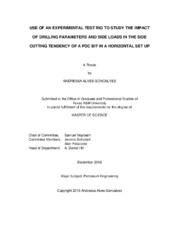| dc.description.abstract | The demand for oil has increased considerably since its first discovery. Consequently, all of the reservoirs that were easy to access and/or explore have already been discovered. To overcome this challenge, the industry had to find a way to find new wells to explore, wells that were previously judged as non-economical, due to either their location or low porosity/permeability. For those reasons, the industry turned to directional wells, facilitated by the advances in technology. An important part of building a successful directional well is correctly predicting the well path. The objective of the present study is to analyze the influence of WOB, ROP, RPM and side load on the steerability of a PDC bit, bringing the work done by Ernst, Pastusek and Lutes (2007) to a horizontal set up and analyzing the response of MSE while sidecutting. Findings suggest how much of an influence the drilling parameters have on steering the bit, and the knowledge of how they affect the set up used during drilling can be a fundamental tool when creating a well path.
The tests were conducted on a horizontal test rig, built by the Mechanical Engineering Department at Texas A&M University, using 8 ksi average compressive strength samples. During the tests, modifications had to be made to the rig in order to accommodate the demands of a petroleum drilling operation. An innovative system was installed to measure shaft deflection through a HD Webcam, turning distance in the pixels from the images captured into real life distance. Through that system it was possible to back calculate the side load being applied to the system, controlling it in real time.
The results showed that two parameters were the most influential on the sidecutting angle of a PDC bit: side load and RPM. Side load was even more significant for lower values, where an increase is much more abrupt. ROP is also expected to have a smaller influence, and it was observed for the sample with the highest RPM. MSE showed an expected response, being opposite to the side load. The results observed were very similar to the ones found by Ernst, Pastusek and Lutes (2007), thus being possible to conclude that when drilling a vertical well, the bit will respond in a similar manner to the changes in drilling parameters as it would in a vertical well. | en |


